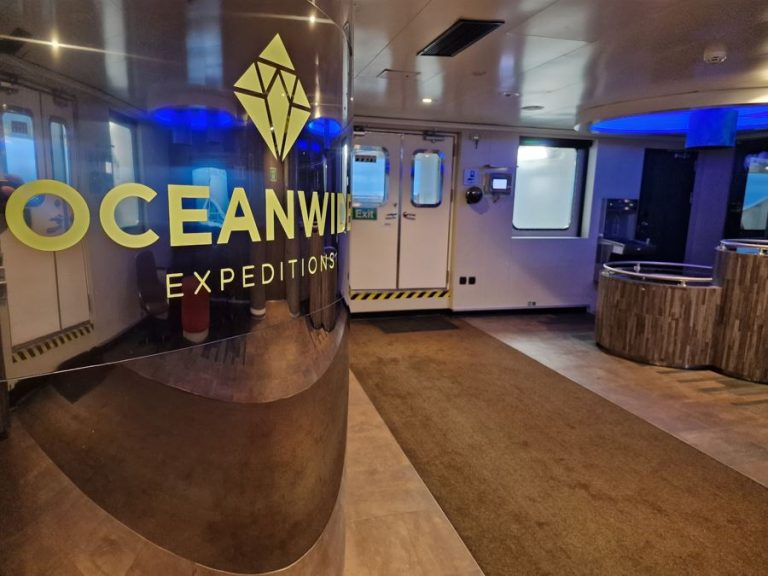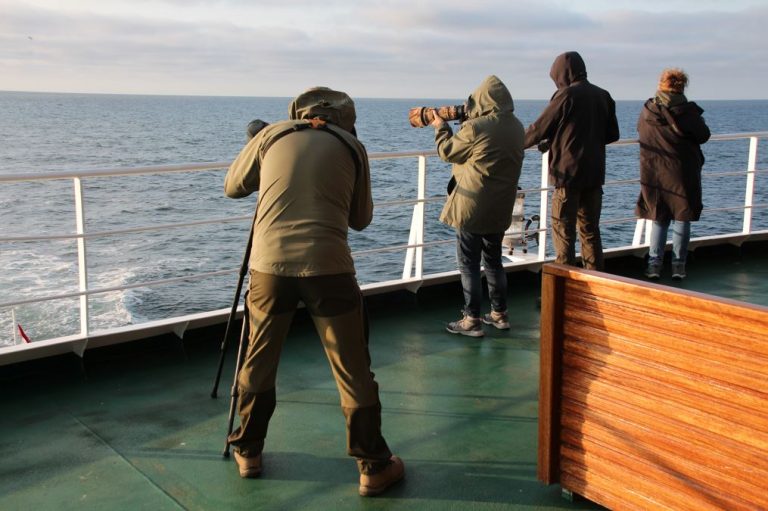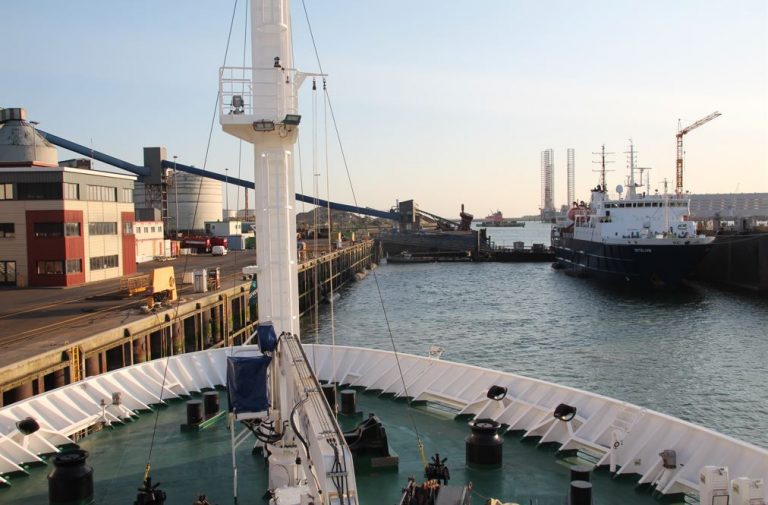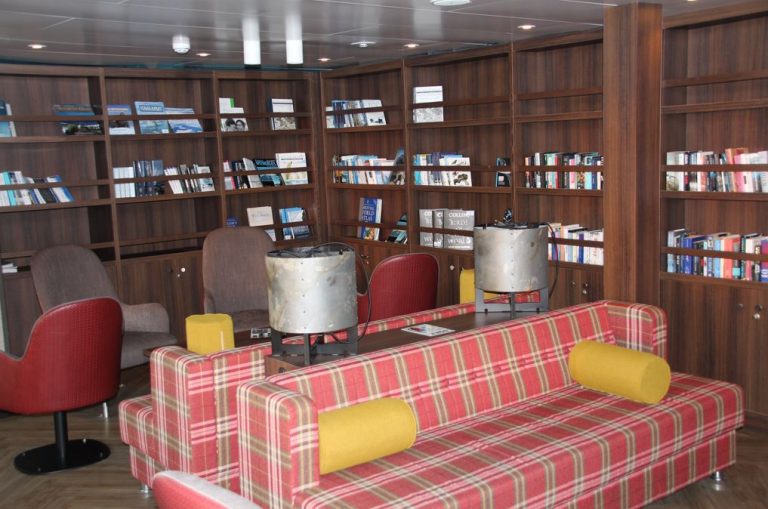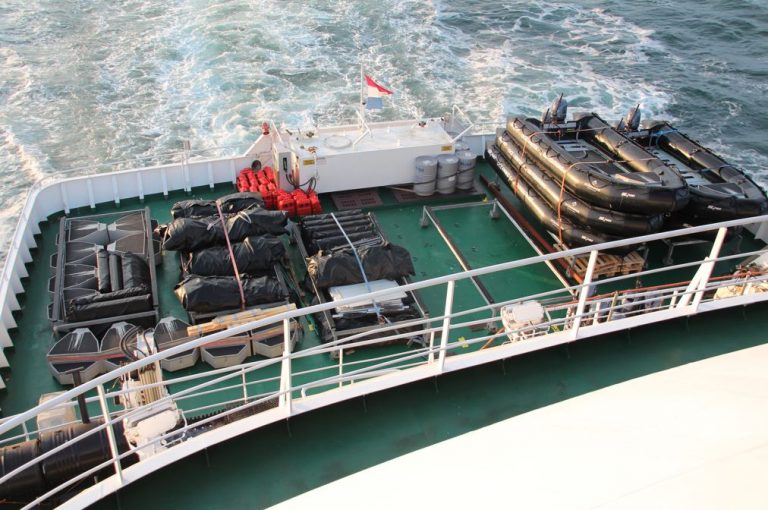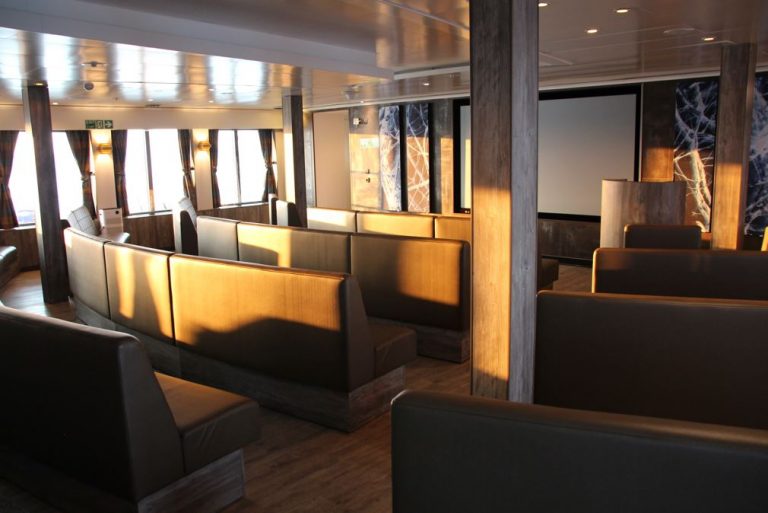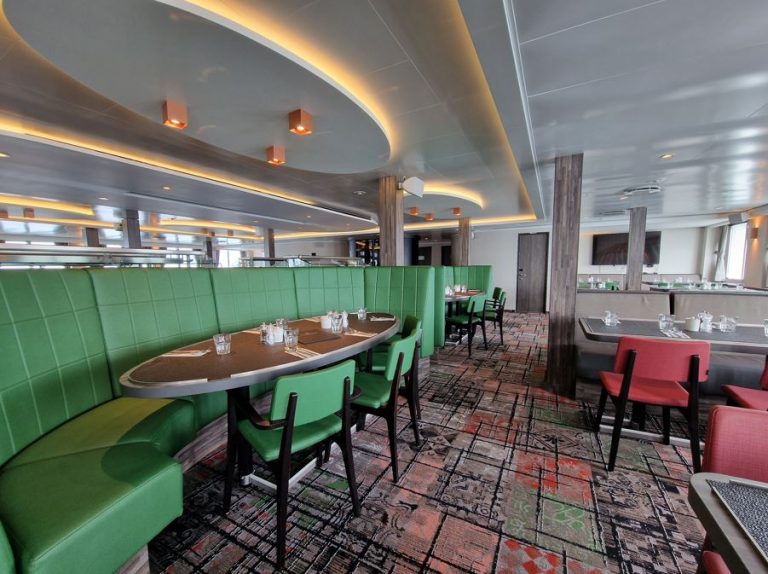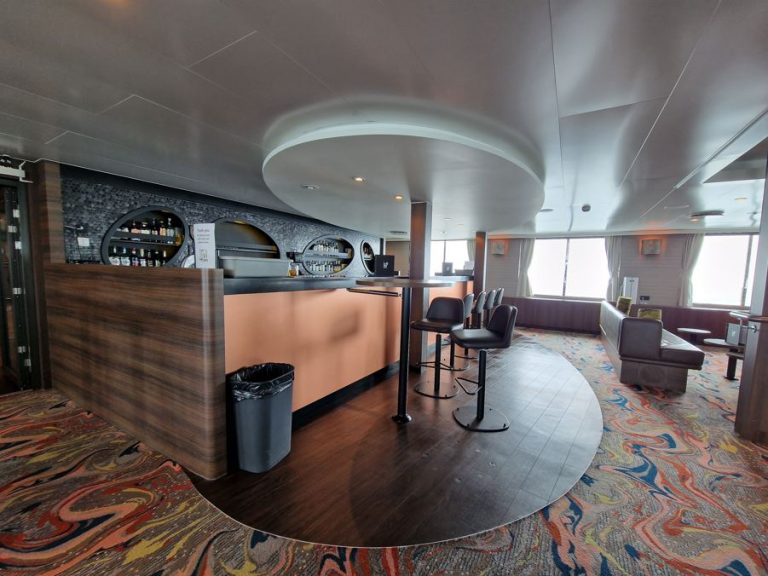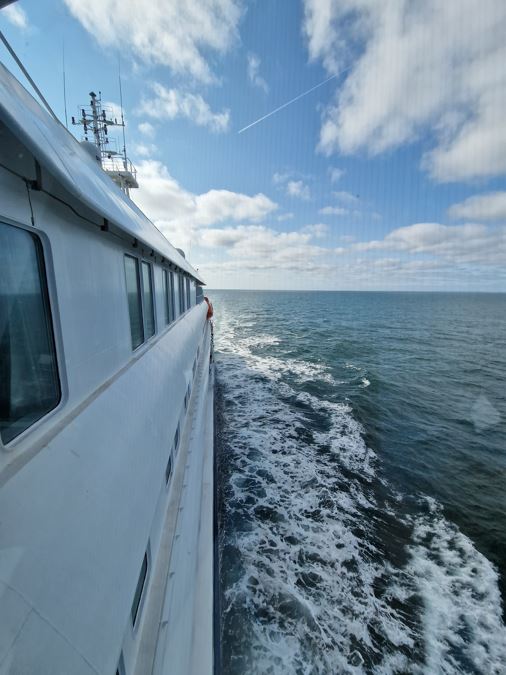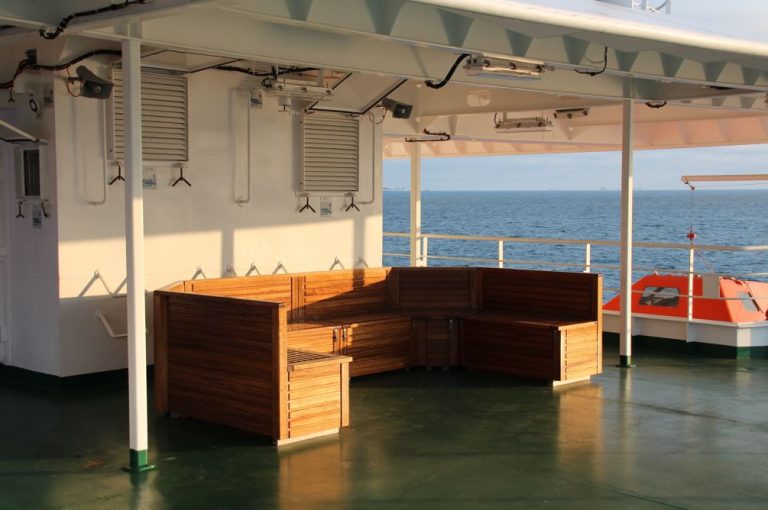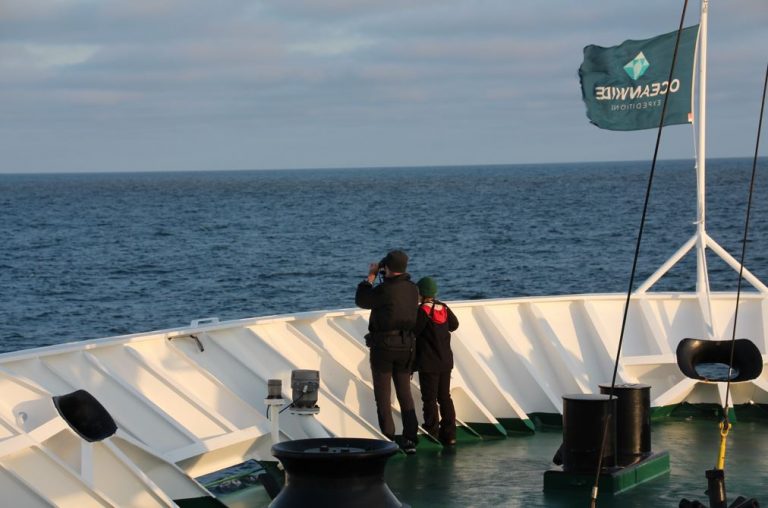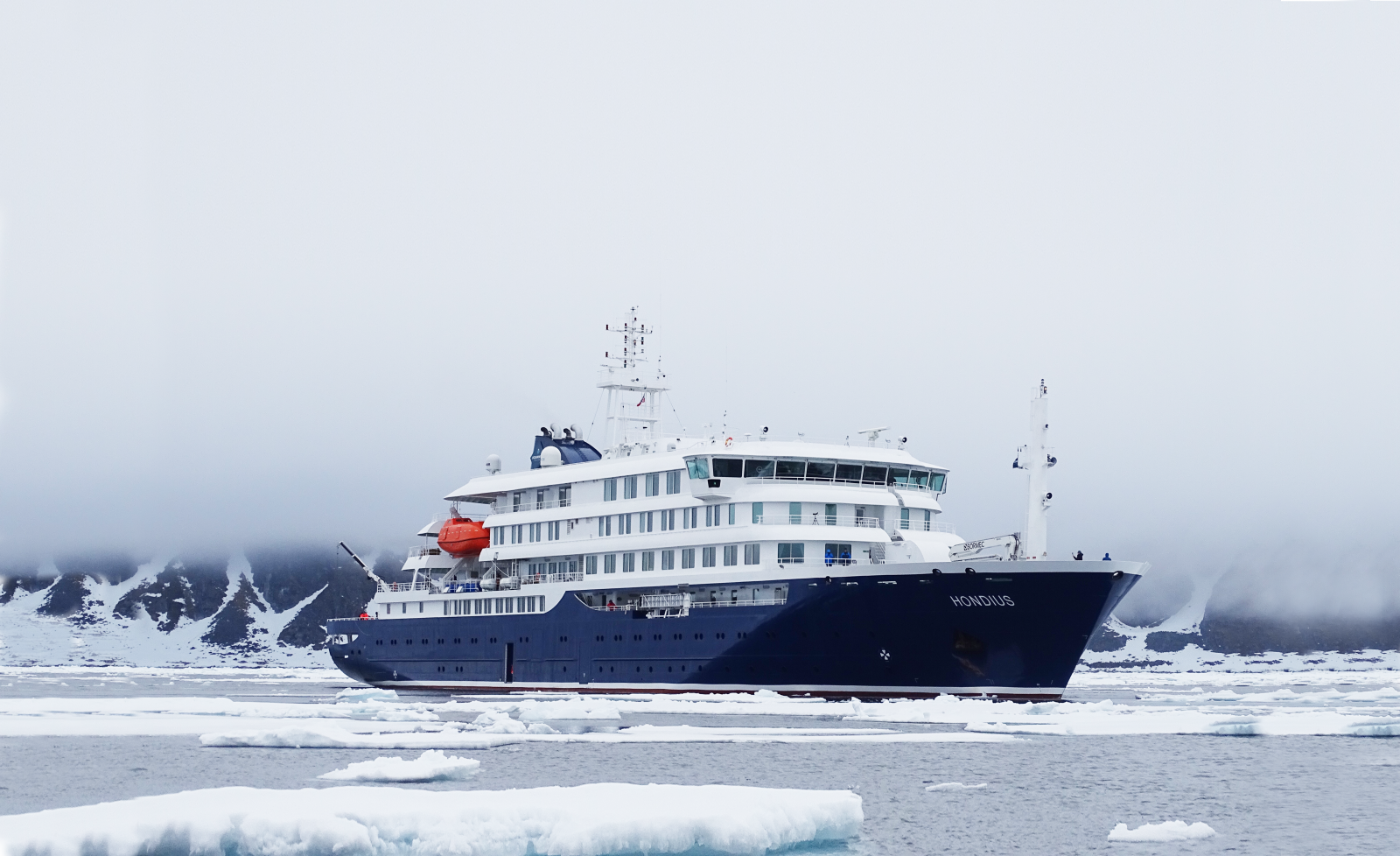Hondius: Dutch expedition ship with a familiar touch
Oceanwide Expeditions is established firmly in the expedition cruise market since 1983. Operating a four-ship fleet, their flagship Hondius showcased what expedition cruising is about on a two-day trip across the North Sea from Vlissingen to Aberdeen in June this year.
Vlissingen is not the most likely port to embark in for a cruise. Its car ferry to England long gone and other Dutch sea ports like Amsterdam or Rotterdam far more easily accessible, Vlissingen these days is a fairly sleepy seaside town and overlooked by all cruise operators but one.
Oceanwide Expeditions is based in Hollands’ North Sea outpost, and the bus driver proudly posts to the head office across the road when shuttling passengers from the train station to the Hondius, the pride of the Oceanwide fleet. Built in 2019 in Croatia and named after a 16th century Dutch cartographer, the vessel on this sunny June Saturday embarks on her season of Arctic expedition cruises.
Hondius Vlissingen
The adventure starts even before the ship departs. “You should be here and you should not be here“, the ship’s 147 passengers are being told while waiting with their luggage on the quayside. The Hondius having just finished a four-week makeover, the shipyard pier is not the usual spot to embark cruise guests, and the Dutch customs officers haven’t arrived either. Check-In therefore starts the old-fashioned way by means of clipboards and pencils before the passengers rush aboard over a shipyard gangway of the rustic kind, their luggage being passed from deckhand to deckhand on the same device afterwards.
A first look at my fellow passengers reveals a crowd you won’t find in the terminals of Miami or Barcelona either: Younger than the usual Cunard or Celebrity crowd, they certainly haven’t dressed up for what’s to come. Their T-shirts feature birds and other animals or funny catch phrases, and some also carry precious camera equipment with them. These guys are definitely not onboard for bingo or late night dancing, the upcoming days for them are there for serious wildlife watching and photography.
Oceanwide Expeditions
Company History
Oceanwide Expeditions traces back to 1983 when the Dutch Plancius Foundation came into life organizing seasonal cruises to a former Dutch whaling station in Svålbard in collaboration with the university of Groningen’s Arctic Centre. Their first ship was the Plancius ex Pollux, a 1950-built former pilot vessel with space for just a handful of passengers. However, these trips became a success, and the foundation expanded into cruising to the Cape Verdes, South America and finally (1991) Antarctica. A larger ship in form of the former Soviet research vessel Professor Molchanov replaced the Plancius at a time when the Dutch businessman Wijnand van Gessel began operating the schooner Rembrandt Van Rijn on sailing cruises to Svålbard in 1993 under the “Oceanwide Expeditions” banner.
In 1996, Oceanwide Expeditions took over the activities and many employees of the Plancius Foundation and began to expand its fleet and scope of cruises. A former Dutch research vessel became the new Plancius in 2009, while another former Soviet research ship, the Marina Svetaeva, joined the fleet as the Ortelius in 2011. In the same year, another sailing ship, the Noorderlicht began cruising in the Svålbard archipelago. Oceanwide’s first purpose-built vessel, the Hondius, was ordered in 2016 for a price of 85 million US-$ and entered service in 2019. Wijnand van Gessel, I am told, at the age of 77 still is the first person to open the Oceanwide office at 6. a. m. each morning to have an eye on what’s going on in his company. He also arrives at the Vlissingen quayside in time this evening to see his ship and staff off to embark on what’s part of his lifetime work.
Hondius at sea
Departure
Onboard, I am sharing a four-berth cabin with three other men – Gunter from Germany, Carl from Belgium and Leon from the Netherlands. With many solo travellers doing the Oceanwide trips for the wildlife and scenery, many are open-minded enough to share their cabin with others, relieving their budget and (hopefully) making new friends with the same interests. On the other end of the scale, the Hondius apart from standard outside cabins also offers a number of luxurious suites – a step taken upon ordering the vessel in accordance with demand. There are no inside cabins onboard.
We assign the upper and lower bunks according to age before storing our luggage under the beds and in the drawers. Occupying an upper bunk, I find the latter without any possibility to put down my glasses, cell phone and watch for the night, otherwise cabin no. 307 leaves nothing to be desired.
Hondius Cabin
Osbervation lounge
Before the Hondius departs, a quite explicit but still funny safety video is shown in the Observation Lounge after which the passengers make their way to their respective muster station. The demonstration there even includes an optional glimpse of one of the lifeboats’ interior, so unlike the safety drills on the large mass-market ships, everyone is clearly in the picture of what he or she is to expect in the case of an emergency.
With still no customs officials in sight, the cruise starts with the introduction of the expedition team. 13 expedition guides accompany the Hondius to the Arctic, among them professional marine biologists, ornithologists and glaciologists. The team is led by Sara Jenner who makes clear in the beginning that “there’s a reason we’re not called Oceanwide Cruises“. The trip to Jan Mayen, Svålbard and the Arctic ice edge as any other Oceanwide voyage bears the character of an expedition. Swell, weather and ice conditions beyond the Arctic circle can change from one minute to another which is why the daily program hanging out in the corridors is only sort of plan A. “When you read the program hanging on the wall, we are most likely working on plan B and C behind the scenes already”, Sara explains.
Wildlife sightings and scenery always come first, so even dinner times onboard the Hondius are subject to change. The passengers are also reminded to have their camera and binoculars within reach at any time since “things can happen“. Guests are also encouraged to lower their voice when public announcements are being made since these may not be repeated. Last but not least, “sleeping is cheating“ – a friendly reminder that onboard and outside activities will take place when the situation allows, not when everyone is fed, showered and rested.
Hondius Birdwatching
On a more serious note she remarks that “I don’t want to see Flip Flops after Aberdeen!” Without any hospital or evacuation device available in the Arctic or Antarctic, taking care of one’s self and others is paramount to guarantee a safe and enjoyable trip for everyone. “We will soon be one family”, she adds with regard to the small number of passengers and crew compartment and the Hondius’ small size, too.
Later in the evening, Dutch customs officials do arrive at last, clearing the Hondius for departure around 8 p.m. We leave Vlissingen in the setting sun, many passengers skipping dinner for the opportunity to take their first pictures of sea birds which can be spotted on the sandbanks of the Scheldt estuary. Only seals can’t be spotted anywhere around, their preferred resting places being the sandbanks outside the harbour rather that the loud and busy basins within. The latter however reveal an interesting sight of another kind: Oceanwide’s Ortelius is tied to the floating shipyard dock nearby from where the Hondius departs, her first cruise of the season still being a few days away.
Ortelius
Onboard
A first walk around the ship reveals a passenger vessel unlike most “mainstream” cruise ships, but also quite unlike her relatives in the expedition cruise market. When designing the Hondius, Oceanwide Expeditions opted for a “pure” expedition ship that leaves out everything that might distract her passengers from the main focus of the voyage. There is no swimming pool onboard, no spa, no casino and no disco. There are not even pictures in the cabin corridors or along the stairways (which is a pity). But of course, the ship is fitted with a well-stocked library that focusses on wildlife reference books, polar history volumes and coffee table books related to everything connected with exploration and marine life.
The library is situated on deck 5 which is the ship’s expedition deck. Its forward part is occupied by the large Observation Lounge which features comfortable chairs and sofas along the sides of the vessel and practical cushioned benches with back rests that can be folded over – depending on where in the room someone has something interesting to say. The lounge also incorporates a bar and a 24/7 self service station where tea, coffee and cakes are supplied. Further aft is the ship’ s lecture room which is used for the daily “recaps”, but also for general presentations or readings.
Library
Library
One deck below (deck 4) is where the restaurant, reception and small onboard shop are situated. You can also find refill stations supplying drinking water on the decks 3 und 4 – a measure taken by Oceanwide Expeditions to help reduce the amount of single use-plastic onboard. At the reception, printed postcards are available for free which is a nice, albeit odd and old-fashioned gesture. Not that there were many public letter boxes in the Arctic or Antarctic, that is.
The 80 cabins for a maximum of 176 passengers onboard are spread all over the decks 3, 4, 6 and 7 which appears bit awkward since on a ship like this, one would normally expect the Observation Lounge to be situated on the uppermost deck. However, Oceanwide when ordering the vessel noted a high demand for luxury suites and opted to put these just abaft the bridge on deck 7.
When it comes to the expedition equipment however, Oceanwide made no compromises. A fleet of 13 zodiacs is safely stowed on the vessel’s aft deck while 28 kayaks are travelling with the Hondius on the boat deck and 2 mobile gangways are tucked to each side of the ship during the trip, too. The greatest advantage over her fleet mates however is a pair of shell doors within the hull that allow for a quick disembarkation – be it into the aforementioned zodiacs or kayaks via a floating platform or right onto the polar ice. Furthermore, cranes on the fore and aft decks are able to lift equipment into the sea and out within a short time so that passengers can spend a maximum of time outside the “mother ship”.
Hondius
Hondius
Behind the scenes, the Hondius is fitted with a conventional diesel engine, thus avoiding teething troubles with unproven new technologies in remote waters. Manoeuvring, too is done by trusted bow and stern thrusters instead of pods. Reaching a total of 4,200 kW and a maximum 15 knots, Hondius is neither a power horse nor a speed queen, but her comparably low draft of 5,30 m allows her to enter bays and harbours that other ships can’t access. Her polar-class is PC6 which allows her to navigate during summer and autumn in medium first-year ice and which puts her in the same league as Hapag-Lloyd Cruises’ Hanseatic Nature, Viking Ocean Cruises’ Viking Octantis and Quark Expeditions’ Ultramarine. That said, Hondius is not an ice-breaker, sailing to the ice (edge) rather than into or through it.
The Oceanwide philosophy
Given the hardware in form of the Hondius and taken in account the historic background of the company, the Oceanwide philosophy is simple: While the ship itself is modern and comfortable, her passengers are encouraged to spend as little time as possible onboard and rather make the best of their time outside the Hondius – be it by walking, hiking, diving, kayaking or discovering the polar world in the ship’s zodiacs. Therefore, the vessel calls at “regular” ports only for embarkation and disembarkation and heads straight to the places of marine or historic interest, spending only short intervals on the open sea.
Regarding its excursions, Oceanwide makes a difference between basecamp activities like shore walks or zodiacs tours which are included and special activities like polar diving or longer hikes which come at a surcharge and sometimes require own equipment to be brought along. When tendering at places where a passenger cap exists, the passengers are split in different groups so that everyone over the day can participate in the same activities without overcrowding sensitive beaches, islands or indigenous settlements.
When zodiac excursions or other outside activities are not possible due to inclement weather, Oceanwide Expeditions follows an open bridge and open deck policy, allowing passengers to see and experience as much as possible onboard – be it from the captain’s viewpoint on the bridge or those parts of the open decks like the fore ship where access on other vessels usually is restricted to pilots and the crew.
Bridge Hondius
A Day in the Life
Sunday morning, somewhere on the North Sea, on the second day of the cruise. Usually, this is a welcome opportunity for passengers to recover from a stressful embarkation day, get up late, have a leisurely breakfast and then see what the day will bring. Not so onboard the Hondius.
By 6 a. m. my cabin mate Carl has been standing on the foredeck for an hour already to watch out for sea birds. And quite a number of his fellow birders, too. To the untrained eye, the most common sights so far have been oil rigs, wind farms and offshore supply ships, but this is only what you can see without proper equipment. The list of bird sightings hanging on the wall next to the lecture room has its first crosses already and also includes some rare species, so getting up early must be worthwhile. The same goes for the onboard library where you should not sink too deeply into reading, otherwise you risk missing breakfast or the first activities of the day. (I made that very mistake and ended up with a thrust of “Franklin fever” after grasping a book about the discovery in 2014 of Franklin’s ship, the EREBUS.)
Lecture Room
After breakfast, groups of passengers are invited to visit the bridge where captain Toni Salo is answering questions regarding his vessel and its operation. Born in Finland and formerly employed on the Baltic Ferry Silja Serenade, Salo is in command of the Hondius during much of the ship’s Arctic season, his Chilean colleague taking over duties for the Antarctic season starting in October. His favourite cruising area is the icy coastline of Greenland which he is looking forward to seeing soon. But he stresses that however beautiful a scenery may look like, safety is always paramount, often leading to a vanguard zodiac exploring ice and weather conditions long before the Hondius herself enters a remote bay or fjord. And although most of the navigation today relies on electronic sea charts, the Hondius still carries with her a set of printed charts for the polar regions as well – just in case. Memory is still fresh of the vessel’s call at Aberdeen last year when it had been so foggy that even in the case of a “safe” port like this, it had been necessary to disembark and embark passengers via tender boats – an unexpected early start into an expedition that was due to get adventurous only much further up north!
Those attending the bridge visit later in the day meanwhile have their appointment on deck 3 for the fitting of muck boots and other expedition wear to be used further northward soon. Apart from a good health, good expedition wear and equipment is the key to a successful expedition cruise, as revealed during another briefing for travel agents and press representatives in the afternoon. “However nice it may be onboard, for us it is important getting people off the ship”, explains Adam Turner, Chief Field Operations manager at Oceanwide Expeditions. Nevertheless, activities like shore walks or hiking tours are being offered in different difficulty levels – easy, moderate and demanding. Some activities can even be offered on short notice if weather permits. This according to Oceanwide is one of the advantages of a family-owned business like theirs where all onboard pull together for the benefit of an unforgettable overall experience.
Hondius
Hondius
That said, the sea day continues to go by without too much time wasted. “Bill welcomes you for a lecture titled ‘Taste of Scotland’” (10:30 a.m.), “Andrew invites you for a presentation about Sea Birds of the North Sea” (3:30 p.m.) and “Anthonie invites you for a presentation of the Dogger Bank” (5:30 p.m.) are only three points of the program that keep everyone up “listening, hearing and understanding”, as Bill would say.
Opportunities and challenges
In between those presentations, Sara Jenner gives her lecture about the Oceanwide experience and what guest can expect from booking an expedition on one of the Oceanwide ships. Full of enthusiasm, knowledge and experience, she is proud of the Oceanwide fleet being able to sail on itineraries that other ships won’t. And that on all others, the Oceanwide expedition team after years of experience knows virtually every polar fox hole, all the walruses’ favourite sandbanks and every whale’s favourite feeding area. She also proudly points to the fact that wildlife numbers despite the ever-increasing number of cruise ships visiting Antarctica have recovered so well during the past years that the disembarkation of passengers on popular beaches had to be aborted lately because of too many animals preventing the zodiacs from landing!
She also points out to the advantages of the different Oceanwide ships. The sturdy Ortelius carries with her its own helicopter, the Plancius is popular due to her smaller capacity of just 100 passengers while the Hondius thanks to her shell doors can disembark all her 176 passengers within just over 30 minutes – enabling more activities for everyone per day.
Hondius Oceanwide Expeditions
Other briefings during that busy sea day onboard the Hondius are being held by the F & B manager and sales director, both of which round off the “information package” for those who are not (only) onboard to watch birds or whales. Food for instance has become more important with expectations having increased not only on cruise ships in general, but also on expedition vessels. However, logistics and supply chains haven’t quite kept up with that development, making every restocking north of Tromsø or south of Ushuaia a challenge still. With supplies ordered to last for two months, the F & B team for instance still needs to order food in July that will be taken onboard in November and is due to last until January! One delayed container or a skipped port of call can thus mean a nightmare for crew and passengers onboard alike – and a diet spare of one’s favourite fruit, spice or ingredient for days on end. Meticulous planning therefore begins at everyone’s restaurant table at noon where your choice of evening menu is retrieved in order to not only help waste food, but also save ingredients that might otherwise run out earlier than envisaged.
Florian Piper, sales director Arctic program, afterwards sheds a light on opportunities and challenges regarding the sales and marketing activities at Oceanwide. Unlike most competitors, he points out, Oceanwide apart from selling whole cabins at a 70 % single surcharge offers the possibility to book single berths in a shared same-sex cabin. This not only opens the expedition cruise market to customers who could otherwise not afford such a voyage, but also offers passengers the chance to make like-minded friends for the duration of the cruise and beyond. Piper describes that policy as “quite popular“, with fares starting at 500 € a day in a shared 4-berth inside cabin. A relatively new challenge however is the non-availability of flight connections, be in the Northern or the Southern hemisphere – a post-Covid phenomenon that also mass-market cruise operators are facing who could easily fill their ships if only their passengers could reach them.
Hondius Lecture Room
During dinner in the evening, the expedition team members mingle with the passengers at their respective tables, bringing a real “family” feel indeed to the cruise as early as on day one. (Needless to say that the dress code onboard is informal throughout the voyage.) And it can get difficult to really eat when listening to stories of encounters with walruses and polar bears, nightly food exchanges between expedition ships far away from land and invitations by local Inuit families who insisted on everyone trying seal meat – an offer you can’t refuse since that would not only be regarded as offence, but could also put precious personal ties at risk that expedition cruise operators can hardly do without.
The day ends at 8:45 p.m. with our first wildlife recap, one of many to follow until Svålbard next week. The scientists onboard compare their own sightings with those among the passengers, and soon bird species are named that many have never heard of before (lest presumed to encounter in the middle of the North Sea). A few lucky fellow passengers have also spotted seals, dolphins, porpoises and whales during the day and have their own photographs posted on the expedition leader’s screen on the wall. Thank goodness there’s Bluetooth, satellite internet and Airdrop these days. How’s been expedition cruising when it started in the 1970s?!
Sundeck Hondius
Aberdeen
Birders are a tough bunch. It’s 6. a.m. the next morning when I get up, but not one, but all three of my cabin mates have already left for bird watching and photography this time! Never have I been on a cruise ship with so many early risers among the passengers. I try to share their enthusiasm by discreetly mingling with them on the forec’s’le, but however intensive I stare into the sky, all I glimpse is sea gulls and a few black dots flying above the waterline. Not to mention the minke whale some claim to have seen in the water a few minutes before. You need a lot of patience an endurance as much as a trained eye to enjoy this kind of onboard activity.
At 6:30 a. m. the night ferry from the Orkney and Shetland Islands passes ahead of the Hondius, making her way into the port of Aberdeen before we do. Half an hour later, the wake-up call sounds across the Oceanwide ship, but since everyone is up and running since sunrise (or earlier) anyway, never has a call of this kind been so useless. Unfortunately, our own arrival at the outer pier of Aberdeen’s historic port at 7:30 a.m. coincides with the opening of the restaurant for breakfast, so those who wish to follow our arrival have to skip a meal once more. But they are rewarded with a spectacular passage along the historic docks on both sides of the river Dee before a yet closer second dock entrance forces the HONDIUS to turn by 180 degrees and enter the inner port stern first.
Hondius
The birders and other wildlife enthusiasts don’t lose time to disembark the ship immediately after customs control to pursue their respective activity of the day. A number of busses have already gathered on the quayside to bring them to places like Newburgh-on-Ythan, Forvie National Nature Reserve and Bullers of Buchan – all known for their abundance of sea birds. For me, disembarkation at 9 a.m. means an all-too-soon Goodbye to the Hondius and her fantastic crew, both of which I have taken to my heart in a very short time. With its focus on exploration and education, the Oceanwide approach to cruising can only be described as delightful and enrichening. Remember this is the time when ships like the Wonder of the Seas carry more than 7,000 passengers, most of whom won’t get to know each other by name at all unless by coincidence. With just 180 passengers cared for by 74 crew members, the immediate and lasting feel onboard the Hondius is that of a very large like-minded family going on a joint adventure.
Taking in mind what’s still ahead on this particular cruise, I feel all the more sorry to leave the Hondius early. But I got my “certificate of polar expertise” shortly before disembarking, handwritten by Bill, signed by Sara and stamped with the “Seal of Approval” – the photo of an Antarctic Fur Seal reminding me of coming back to one of the Oceanwide ships as soon as possible.
Don’t miss more updates, news and reviews about Oceanwide Expeditions on Cruising Journal.


